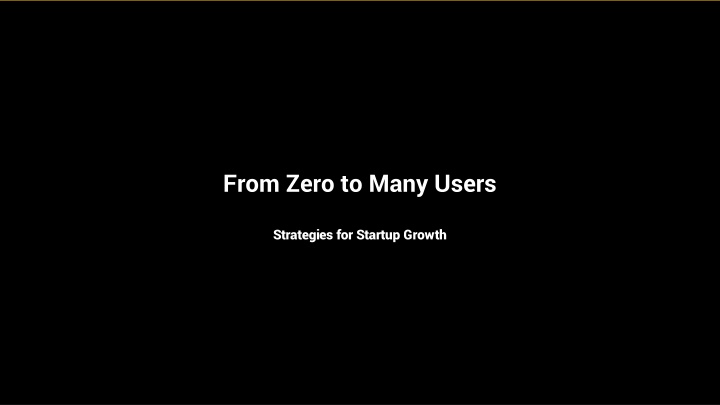
Strategies for Startup Growth: From Zero to Many Users
Learn valuable strategies for startup growth, from dedicating time to your venture to understanding the problem you're solving. Avoid common pitfalls with tips on industry immersion, iterating based on feedback, and building a minimum viable product. Get insights on acquiring users, gaining feedback, and developing a successful startup.
Download Presentation

Please find below an Image/Link to download the presentation.
The content on the website is provided AS IS for your information and personal use only. It may not be sold, licensed, or shared on other websites without obtaining consent from the author. If you encounter any issues during the download, it is possible that the publisher has removed the file from their server.
You are allowed to download the files provided on this website for personal or commercial use, subject to the condition that they are used lawfully. All files are the property of their respective owners.
The content on the website is provided AS IS for your information and personal use only. It may not be sold, licensed, or shared on other websites without obtaining consent from the author.
E N D
Presentation Transcript
From Zero to Many Users Strategies for Startup Growth
Introduction Thanks for having me! Today, I will be discussing how to go from zero zero users to many users. Learn from my past mistakes and failures to avoid avoid common pitfalls in startup growth. Remember that every business is unique, so so consider this advice as general guidance. Photo by Pexels Photo by Pexels
Dedicate Time to Your Startup Have a lot of time on your hands to concentrate concentrate on your startup. Immerse yourself in developing solutions to the to the problem you're trying to solve. Focus and dedicate compressed time in a row for maximum effectiveness. Avoid context switching and stay highly focused on the task at hand. Photo by Pexels Photo by Pexels
Avoid Novice Startup Approach Do not keep your idea a secret and build in isolation. Seek feedback and iterate based on user input. input. Launch early and gather initial user feedback. Do not rely solely on acquiring users through paid channels. Photo by Pexels Photo by Pexels
Understand the Problem You're Solving Describe the problem your startup aims to solve in one sentence. Verify if the problem is something you are passionate about. Validate if the problem is something others also experience. Avoid building a product for a problem you don't genuinely care about. Photo by Pexels Photo by Pexels
Immerse Yourself in the Industry Become an expert in the industry you're entering. Work or learn in the same sector to gain insights. Understand the inefficiencies and identify opportunities. Get to know your customers and their pain points deeply. Photo by Pexels Photo by Pexels
Start with a Minimum Viable Product Build the smallest feature set to solve the core problem. Optimize for the initial stage of growth and user acquisition. Avoid trying to build features for future scalability. Focus on the generic case and tackle edge cases later. Photo by Pexels Photo by Pexels
Get Feedback from Early Users Enable users to easily provide feedback and support. Engage with users through surveys and personal conversations. Go beyond quantitative metrics to understand user experiences. Analyze retention rates and customer satisfaction. Photo by Pexels Photo by Pexels
Optimize for Sustainable Growth Improve customer retention and increase CLTV. Analyze retention curves and cohort data. Focus on delivering a great experience to retain users. Continuously monitor and iterate growth strategies. Photo by Pexels Photo by Pexels
Harness Viral Growth Deliver an exceptional experience to customers. Encourage customers to refer others through customer touch points. Design effective referral program mechanics. Leverage word-of-mouth marketing to drive viral growth. Photo by Pexels Photo by Pexels
Use Paid Growth Strategies Allocate budget to acquire new users through paid channels. Experiment with different marketing channels and tactics. Optimize performance marketing and iterate based on data. Evaluate ROI to ensure sustainable paid growth. Photo by Pexels Photo by Pexels
